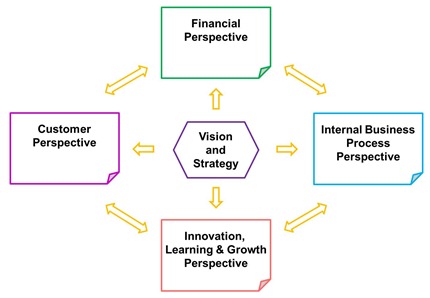So much of western thinking divides the world into four. You only have to look at management models to see this at its extremes: psychometric profiling, such as DISC®, personality types such as Merrill-Reid or Lifo®, and most common of all, the innumerable “four box models”. These all have something valuable to tell us, but are all hampered by two features: they allow only four classes in an infinitely varying world and they have to go to great lengths to then assure users that some admixture of classes is not only allowed, but encouraged.

This is South Korea’s national flag. It too represents an ancient division of the world into four components; in this case, the four major tri-grams of the I Ching stand for (clockwise from top left): heaven, water, earth and fire.
.
One model stands out by putting the balance to the forefront and making its four categories the secondary feature of the model. This is Robert Kaplan and David Norton’s Balanced Scorecard.
Balanced Business Scorecard
In one of Harvard Business Review’s most read articles (it appears in their compilation of ten must-read articles), Kaplan and Norton set out how a business can achieve success by focusing on four different areas; not just on financial performance.
The principles at stake here are simple: if you build a great business, financial success will follow, focus only on the financial metrics and you cannot build a great long-term business, and if you are going to focus more widely, you need to develop measures of success that are as rugged as the well-established financial measured.
It takes me back to my old favourite adage: “what gets measured gets managed” – see the earlier pocketblog: “Are targets a waste of time?”
Kaplan and Norton’s four Perspectives
The original article (Harvard Business Review Sept-Oct 1993) looked at a case study of engineering company, Rockwater, whose four perspectives were: financial, internal processes, innovation & learning, and customer. These have become crystallised to the extent that many businesses take these categories off the shelf.
However, whilst they are valuable for many businesses, the principle of selecting four perspectives that can dictate the future success of your enterprise is far more general than this. Whether you run a business, a public service, a charity or a small group of people in any sphere of life, the fundamental methodology holds: find your key perspectives and develop the measures that you value most.
A Balanced Scorecard Methodology
Seven steps are all it takes… and a lot of careful thought and involvement of colleagues. Skipping those tough parts, here it is in a nutshell.
- Make sure you have a clear vision and strategy
- Find the performance categories that best link your vision and strategy to success (Here are some different examples: service standards, thought leadership, marketing activity, performance management, internal morale)
- For each perspective, define a small number of objectives that support your vision and strategy
- Develop standards or ways to measure progress and build simple systems to monitor and communicate performance against each perspective
- Spread the word throughout your organisation that these measures will drive your reward and promotion mechanisms
- Monitor performance and compare it with your objectives
- Take action to bring performance in line with your objectives
Some Management Pocketbooks you might like
The balanced scorecard can be used at several levels from strategy to day-to-day operations.


In my opinion, balanced scorecards shouldn’t always be “balanced” http://alignment.wordpress.com/2007/02/12/is-a-balanced-scorecard-bad
You might also be interested in my Quick Guide to Performance Management http://alignment.wordpress.com/2010/09/27/quick-guide-to-performance-management